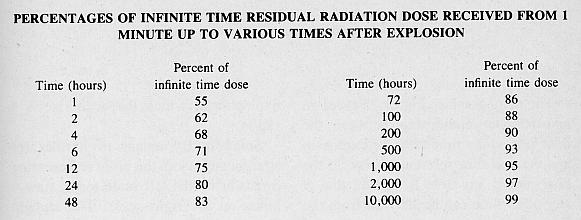The average lethal dose, called LD-50, is defined as the radiation dose
which will determine within one hour the death of 50 percent of the
population which has suffered the irradiation. Concerning the units
of measure of radiation, scientists have adopted the RAD [1].
The Russians use the roentgen: 1 roentgen 0 0,88 RAD. Nato uses the
centiGray (cGy) which corresponds to 1 RAD. The REM (Roentgen
Equivalent Man), i.e., the dosage of ionizing radiation that will cause
the same amount of injury to human tissue as 1 roentgen of X-rays. The
number of absorbed REM radiation equals the number of the RAD
absorbed multiplied by the effective efficacy of a particular type of
emitted radiation (gamma, beta, alpha, neutron). As well, the
REM is also the unit of dose/equivalent which is equal to the product
of the number of the absorbed RAD and the "quality factor"
of the radiation. Hence:
1 RAD gamma radiation = 1 REM
1 RAD beta radiation = 1 REM
1
RAD alpha radiation = 10 REM
Another unit of measure of radiation is the curie [2]
which corresponds to the number of nuclear disintegrations
per unit of time. In the International System of Units the curie has
been substituted by the becquerel. One curie corresponds to 37,000,000,000
becquerel. The curie is mostly used to verify the radioactivity level
of a given sample, for example, one cubic meter of air, one liter of
milk, one kilogram of vegetables or one square meter of ground.
As we have already seen, half-life means the time required
for something to fall to half its initial radioactive value
and, in particular, the time for half the atoms in a radioactive substance
to disintegrate. The half-life period insofar as radioactive elements
are concerned, varies from a fraction of millionths of a second to millions
of years nor can an element's radioactivity be destroyed by any means,
nor can the sequence of radioactive radiation be altered. Hence the
amount of radioactivity on the planet can decrease only as a function
of time. The decaying time of radioactive fallout
obeys to a physical law called "rule of seven" so that the
radioactivity decreases by a factor of 10 for each sevenfold in time
as we can see from the table on the right:
| TIME | RADIATION (rads/millirads/hr) |
|
|||
| 30 minutes 1 hour 2 hours 3.5 hours 7 hours 14 hours 24 hours 2 days 4 days 7 days 14 days 28 days 50 days 100 days 200 days |
2,000 r/hr 1,000 r/hr 400 r/hr 200 r/hr 100 r/hr 40 r/hr 20 r/hr 10 r/hr 4 r/hr 2 r/hr 1 r/hr 0.4 r/hr or 400 mr/hr below 200 mr/hr below 100 mr/hr below 40 mr/hr |
||||
This holds so long as no more fallout gets deposited otherwise the radiation measurement must be started all over again. This "rule of seven" is not anymore accurate after a lapse of two or three months.
[1]
A unit of absorbed ionizing radiation equal to 100 ergs per gram of
irradiated material.
[2]
A unit of radioactivity equal to the amount of a radioactive isotope
that decays at the rate of 37,000,000,000 disintegrations per second.
